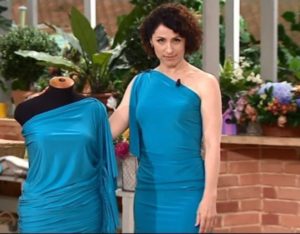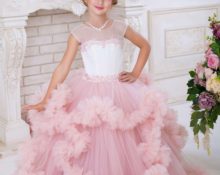Viscose is an artificial material invented in the 19th century. The composition is similar to natural cotton and linen fabrics and has similar properties to them. The most common are staple and staple viscose with a light silky sheen of the material; they are soft, delicate, and wear-resistant. Viscose allows air to pass through well, is hygienic, does not electrify, and is pleasant to the body. Does not require ironing after washing. Such properties made viscose popular.
Clothing made from viscose is in great demand, the range of products includes: dresses, pajamas, shirts, jackets. Viscose fabrics are widely used in sewing clothes for children. This master class will tell you how to sew an outfit in one evening.
Recommendations for working with fabric
Viscose is an ideal material for a summer dress. You can sew a lot of different styles: from simple - summer with a floral print, to sophisticated - floor-length evening, cocktail and open-backed.
Important: Along with its advantages, viscose also has one significant drawback - it shrinks after washing - up to 40%.In order not to encounter such a surprise, before cutting the fabric, it is necessary to do decating: the material is wetted and dried. Viscose fabric with natural fibers just needs to be ironed with a steam iron.
Devices for work:
- textile;
- scissors;
- tape measure;
- chalk;
- pins;
- pen and paper;
- needle, thread;
- sewing machine.
Simple options for viscose dresses.
It’s easy to sew a viscose outfit with your own hands; even an inexperienced seamstress can handle the sewing. Here are three options for simple models that take from one to three hours to make.
Option one: Greek style dress
 This model is perfect for evening walks and attending special events.
This model is perfect for evening walks and attending special events.
- 2 measurements are taken: OB (hip circumference) and OT (waist circumference). Compare and select a larger value; it will be needed when cutting.
- A piece of fabric 1.50 m by 1.50 m is folded in half lengthwise, with the fold facing toward you.
- Half of the larger value is set aside from the fold of the material, a notch is placed - this is the width of the future dress. A vertical line is drawn upward from this point, but does not reach the top edge by 25 cm.
- The machine stitch will be laid along the drawn perpendicular, the second line will run parallel at a distance of 1 cm from the first.
- A drawstring is pulled between the seams and the dress is pulled together along the side seam. The edges do not need to be processed, as they do not crumble.
- The outfit is put on, the shoulder seam is pinned with a decorative pin or fastened with threads to match the material. Greek dress - ready!
Option two: wrap dress with an open back
 Tight-fitting outfits are suitable for slender figures. Many young girls will be happy to add such a model to their wardrobe.
Tight-fitting outfits are suitable for slender figures. Many young girls will be happy to add such a model to their wardrobe.
- Measurements are taken: W (width of the dress along the bodice), Ob (hip circumference), top length, distance from the waist to the desired length of the neckline.
- the fabric is folded towards itself. A straight bottom line is drawn, and the length of the dress is laid upward from it, which depends on the style of the chosen product. A horizontal waist line is drawn. Since our product is wrapped, the width at the waist and hips will be the same, so there is no point in highlighting the hip line separately. Measurement Sb (half hip circumference) with an increase of 20 cm and divided by 2 is set aside from the fold of the fabric. The length of the top is measured from the waist line along the fold. It remains to set aside the width of the product along the bodice. The waist and hem lines are connected by a straight line, the width of the bodice and the waist line are connected by a smooth curve.
- The top of the neckline is processed with a facing; it can be cut out in one piece by adding 2.5 cm to the length of the top. A drawstring will be inserted into the neck: the width when cutting is 4 cm, when finished it is 1 cm, which is tied around the neck. The armhole is turned up and adjusted to the main product or processed as a neckline (facing). Ties 60–70 cm long are attached to the waist.
Option three: semi-fitted dress
For older women, semi-fitted viscose silhouettes are best. Since the fabric is quite thin and tight-fitting, there is no need to show off all your charms.
- for such an outfit you will need two measurements: OT (waist circumference), RTA (front waist length);
- take a piece of material: 3 m long and 1.4 m wide, fold it along the length and then along the width - you get 4 layers of fabric; located with the fold towards itself;
- From the top fold down, the RTA measurement (front waist length) is laid down; a horizontal waist line is drawn through this point. The CT value (half the waist circumference) is displayed on it with an increase of 3-4 cm.A hip line is drawn down from this line at a distance of 18 cm. An extension is made from the waist to the bottom. The sleeve line is smoothly formed, running from the waist up and falling to the bottom. The top fold of the material will be a dropped shoulder, turning into a long sleeve;
- In this dress, only one seam is sewn: starting from the hem line and ending with the bottom of the sleeve;
- the neck is processed by facing, which is cut out according to its shape; or bias tape, you can buy it in a store or cut it yourself from the same fabric. The bottom of the sleeve is done with a zigzag stitch. A drawstring can be inserted along the waist line. The side seams are complemented by slits.
Dresses with drapery look good from viscose fabric, but these are already complex models and cannot be done without a base pattern. The pattern is modeled: drapery lines are drawn, cut and spread to the required width. It’s nice and easy to sew yourself an outfit that will delight you and give you an incentive for further creative ideas. Improve your skills and move on to creating more complex models.



 0
0






Everything is clear with the neckline. I don’t understand how to process the bottom of the dress?